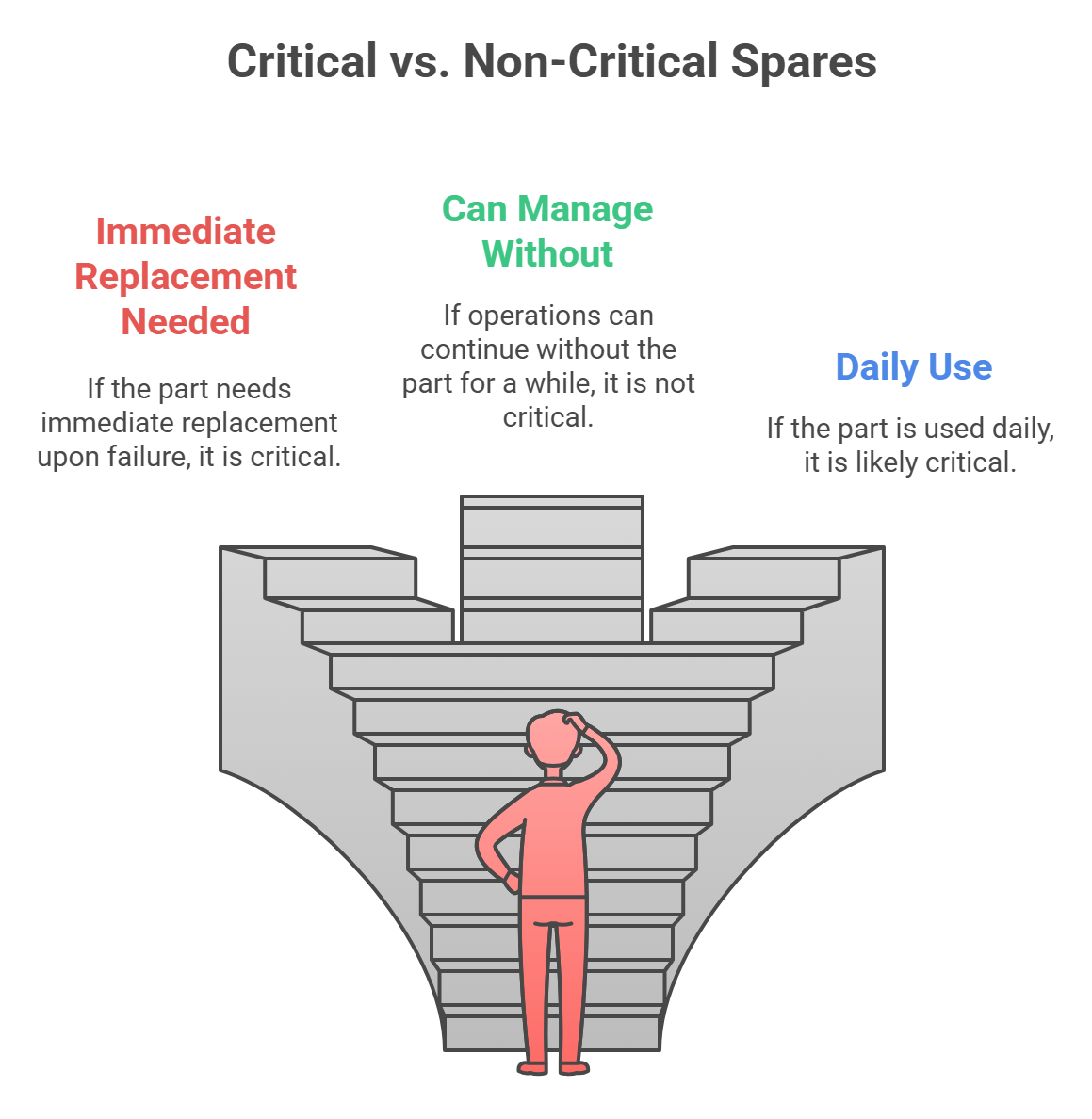
Successful parts inventory management involves a lot of careful balance, especially when it comes to critical spares. On one hand, keeping too many component parts around can be expensive, both in terms of money and space. Most operations can’t afford to keep a backup of every part they’ll ever need in the warehouse.
On the other hand, if you don’t have critical parts in stock, you’re much more likely to experience unplanned downtime or safety hazards. You can’t afford to stop production every time a key part wears out, especially considering the reality of today’s supply chain issues.
So, how can you decide which asset components to keep in stock? In this article, we’ll show you how to assess the criticality of spare parts. We’ll also talk about how criticality ties into a more proactive maintenance strategy.
What Are Critical Spares?
Critical spares are the components that your operation must have in order to stay up and running. Without these parts, your production line will break down, and you won’t be able to meet deadlines or deliver products.

Most of the time, critical spare parts refer to the components that are necessary for your key production equipment. However, in many cases, your maintenance tools for these parts are also critical. Critical spare parts management includes responsible management of maintenance tools and parts, as well as any important components that are custom-made or that take a long time to ship.
Not sure whether a particular part is critical? Ask yourself: If that part fails, how quickly will you need to replace it? If the answer is right away, then it’s a critical part.
On the other hand, if you can manage just fine without it for a while, then it’s not critical.
You may also want to think about how often you use a particular asset. If you rely on some of your equipment every day, then it’s probably critical, even if it isn’t part of your production line.
Talk to your teams and get their views on which equipment is most important. That’s the first step to carrying out an Asset CriticalityAssessment (ACA).
Performing a Spare Part Criticality Assessment
Typically, team members will all have different ideas of which parts are most critical. If you haven’t already done an ACA, also called a spare part assessment, you should run one as soon as possible. Talk to everyone involved and get detailed reporting on the assets that they identify as critical. Computerized Maintenance Management System (CMMS) software is also a valuable tool in assessing asset criticality.
Click here for step-by-step instructions on how to perform an asset criticality analysis.
Once you’ve determined which assets are most important to your operation, it’s a matter of making sure that you keep the critical parts for those assets in stock.
The Benefits of Effective Criticality Assessments and Critical Spares Management
These are the key factors that show why critical spare parts management matters for your core operations.
Avoid Costly Downtime
Keeping critical spares on hand means you’ll see a drastic reduction in unplanned downtime. You won’t be caught off guard when a motor suddenly stops running or when a fan breaks down, because you’ll have a backup part in your storeroom. As a result, you’ll keep your plant running longer and avoid excess costs from unplanned downtime.
Reduce Costs for Parts and Shipping
You’ll also likely pay lower shipping costs and may even pay less for each spare part. Planning ahead means you’ll avoid expensive rush shipping and be able to look around for the best prices available.
Improve Inventory Levels
Of course, figuring out which spares are critical can also help you make better use of your storage space. Once you determine which parts are critical, you can eliminate many of the non-essential parts from your warehouses. That means that your storage spaces will be leaner, better organized, and easier to navigate.
Enhance Operational Efficiency
With the right parts in stock, you’ll also reduce lead times to enable more efficient maintenance planning and execution. Effective parts inventory management also helps strengthen relationships with your suppliers, which, in turn, can improve your critical spare management. As a loyal customer, you’ll likely be the first to know when supply chain disruptions occur.
Plus, predictive maintenance technologies can help identify potential failures that, if left unchecked, could lead to costly downtime, production delays, and extensive repairs. This alerts your team to restock those repair parts.
What Is the Difference Between Critical and Strategic Parts?
Teams must keep critical spares on hand to prevent immediate downtime or safety risks. But many organizations also stock strategic spare parts to reduce risks such as long lead times, obsolescence, or sourcing challenges. Both strategic and critical spares are important, but they serve different purposes.
Unlike critical spare parts, strategic spare parts address issues that might not stop operations immediately but could compromise long-term asset functionality or lifespan. The goal of keeping strategic parts on-hand is to maximize an organization’s ability to maintain and support its assets over time, so technicians can continue to maintain assets without replacing them.
Common reasons to keep strategic spare parts in an inventory include:
- Obsolescence: As equipment ages, spare parts may become harder to find. Keeping a strategic inventory of spares helps ensure the right parts are always on hand.
- Long lead times: If a part takes an unusually long time to procure, keeping a small inventory of parts can help minimize downtime.
- Sourcing challenges: Global supply chain disruptions or vendor reliability issues can make certain parts difficult to obtain. Maintaining a strategic stock helps reduce the risk of assets becoming irreparable due to unavailable components.
Whether you’re managing critical or strategic spare parts, following best practices enables you to support operational continuity and reliability with your spare parts management strategy.
What Is the Difference Between Insurance Spares and Critical Spares?
Insurance spares are a subset of strategic parts. These are parts that a facility doesn’t expect to equip for an asset’s normal functions; they’re very rarely needed. However, if these parts aren’t available during a critical equipment failure, it would lead to excessive, costly downtime with major revenue loss.
These spares are often expensive and come with long lead times. So, if you wait to order them until an equipment failure occurs, it compounds the impact to budget and time.
These parts are called insurance spares because having them on hand is a form of insurance against significant potential loss.
What Are Four Types of Spare Parts?
Apart from classifying specific parts as critical versus non-critical, there are other types of parts you can order.
Original Equipment Manufacturer (OEM) parts are those produced by the manufacturer of your asset. They may be among the most expensive, as they’re typically high-quality and very reliable. However, since the original manufacturer designs and produces them, they’re also the most likely to match your asset perfectly. Most notably, OEM parts won’t void your equipment warranty.
Aftermarket parts come from a third-party manufacturer. They’re less expensive compared to OEM parts, but many good-quality aftermarket parts feature premium engineering to match OEM specifications. It’s important to research the quality and durability of these parts. Also, some aftermarket parts may void your asset warranty.
Remanufactured parts are non-new parts that have been refurbished to function like new. They’re cheaper than OEM parts but have a more limited lifespan. Remanufactured parts may not be available for all equipment types, and not all parts are available as remanufactured parts.
Finally, used parts are non-new parts that have operated in equipment previously but have not been refurbished. This makes them very inexpensive. However, due to their wear and lack of refurbishment, the functionality and useful lifespan of these parts is unreliable. Employ used parts sparingly and cautiously — never for high-risk or safety components.
How To Adopt a Critical Spare Parts Inventory Strategy
Once you’re ready to implement this inventory management approach, here are some of the first steps you should take:
- Conduct your asset criticality assessment. Start by classifying parts as critical or non-critical.
- Modify your maintenance strategies. Forward-thinking strategies such as predictive maintenance, preventive maintenance, and Condition-Based Maintenance (CBM) improve accuracy in maintenance planning and inventory levels.
- Revise your orders for lower-demand spares. Check ordering frequency and inventory levels for non-critical items at your organization and adjust accordingly, so you can free up space for critical items.
- Adjust budget allocation for critical spares. Auditing procurement for non-critical spares should allow you to reallocate new funds for essential parts.
- Order sufficient critical spares. Now that you know which parts are critical, it’s time to put in the appropriate orders to get your inventory levels to where they need to be.
- Monitor asset performance with essential metrics. Use calculations such as Mean Time Between Failures (MTBF) and Mean Time to Repair (MTTR) to make data-driven decisions.
Learn more about the seven most important maintenance metrics.
This balance of assessments, strategies, inventory management, and asset performance monitoring ensures an efficient and effective approach to implementation.
Best Practices for Critical Spare Parts Management
Adopting a few key practices can transform your critical spare parts management system. Here are some of the best strategies.
Set Effective Priorities
Assess how often your critical spare parts need to be replaced. Start by carrying out an asset criticality analysis or conduct a new one if it’s been a while since the last ACA. Studying your work order history will also give you more insights into each asset’s maintenance needs.
When ordering and stocking parts, prioritize the critical spares that frequently need replacement. Also focus on obtaining parts with long lead times so that you’re not caught off guard by unexpected shipping delays.
Use an Effective Critical Spares Tracking System
Use a cloud-based tool to track the location of your critical spares, especially if your team has multiple warehouses or facilities. Look for a tool that can also track when parts were last ordered and when they need to be reordered. It’s a good idea to use QR codes or RFID tags that you can scan to automatically update inventory.
Standardize inventory processes so that all of your inventory is tagged and scanned upon arrival in the warehouse. This will require some additional training and supervision at the outset, but it will pay off quickly. Systematic tagging and scanning mean you’ll be able to easily locate every piece of inventory in your organization across all of your facilities.
Adopt a Proactive Maintenance Strategy
Proactive maintenance takes you out of reactive mode, giving you data-driven insights to improve maintenance and inventory planning.
Approaches like preventive maintenance and predictive maintenance extend the lifespan of your assets and reduce unexpected downtime at your facilities. As a result, you won’t face sudden, unexpected breakdowns that leave you scrambling for spare parts.
Discover how the right EAM solution can cut downtime and help you stay proactive.
Critical Spare Parts and Proactive Maintenance
A proactive maintenance strategy can help ensure that you always have the critical spares you need in stock. Proactive maintenance means staying a few steps ahead of equipment failure by keeping tabs on your asset health. If you monitor your assets for early signs of defects, you’ll always know ahead of time when a part needs to be replaced or repaired.
This can be as simple as having your crews carry out route-based vibration monitoring on a regular basis. Changes in vibration patterns sometimes indicate new machine faults. The sooner you discover those faults, the sooner you can order the parts you need to fix them.
You could also build a vibration monitoring system using wireless vibration monitors and a CMMS. Vibration monitors collect vibration data on a continuous basis so that you never miss any key information. And you can configure your CMMS to automatically create a work order whenever the vibration levels exceed your parameters.
How To Prepare for Critical Spare Parts Shortages
Supply chain snarls are a fact of life, and that’s not likely to change. Fortunately, careful planning can help cushion the impact of shortages and price hikes. Here’s how to protect your bottom line.
Improve Your Forecasting Capabilities
Stock up ahead of time on critical parts so that sudden shortages don’t impact production as much as normal. Use historical data analytics to predict when you’re likely to need more parts and order ahead of time. Work order history can tell you how often parts need to be replaced; inventory tracking can tell you how many parts you have remaining.
Analyze Lead Time
If you’re facing long lead times, perform an analysis to identify exactly where the bottlenecks are. Try asking the following questions:
- Is your team reordering parts on time, or is there a delay in the process?
- Are you unloading orders promptly and tracking the location of each new shipment?
- If there’s a delay in the shipping process, can you figure out which vendor is causing the slowdown?
Pinpointing the source of the problem can help you correct and solve it.
Dual-Source Your Suppliers
Don’t rely on just one supplier to provide critical spares. Instead, diversify as much as possible. Using multiple suppliers means that if there’s a problem with one of your vendors, you can pivot to another supplier, saving you from potential headaches.
Increase Your Critical Spare Parts Inventory Accuracy
If your inventory count is unknown or inaccurate, it’s difficult to avoid parts shortages. Build a reliable tracking system so that you always know what you have in stock, and what you need. Tools like a CMMS can help. This practice allows you to plan ahead and avoid expensive ordering tactics like expediting parts or facing expensive downtime while you wait for a parts shipment.
Solving Three Common Critical Spare Parts Challenges With a CMMS
A good CMMS can help you address the most common headaches associated with inventory management. Here’s how.
1. Supply Chain Issues
CMMS software delivers data-driven insights into asset health, so you have plenty of time to plan ahead for maintenance work. Accurate condition forecasting allows you to order parts well ahead of time, protecting you from last-minute supply chain hiccups. A good CMMS will even automatically prompt you to reorder parts when you run low.
2. Slow-Moving Parts
Slow-moving parts are components that have been sitting unused in your inventory for an extended period of time. They take up space that you could use for other, more critical spare parts. If they sit too long, slow-moving parts become obsolete.
A CMMS can analyze your past inventory orders, replacement rates, and time-in-inventory to help identify and manage slow-moving parts. You can even use a CMMS to create a warning system, so that maintenance team members get an alert whenever there’s an excess of slow-moving parts.
3. Global Parts Sharing Across Sites
A CMMS acts as a central repository for all of your inventory data — an invaluable resource when your organization manages multiple worksites.
A CMMS lets you see exactly where all of your parts are. If one of your worksites suddenly needs a replacement component, it may be easier or cheaper to ship those parts from one of your other facilities instead of paying for expedited shipping from a supplier.
Working With the Experts
Shifting to a proactive maintenance approach can do wonders for your whole operation. It makes inventory management much easier, especially when it comes to critical spares and determining asset criticality. For some companies, it can also lead to major savings, like reducing more than $1 million in spare parts inventory. Ultimately, proactive maintenance can boost productivity, and minimize downtime. But making this shift isn’t always easy. If you’re operating with a lean workforce, you may face special challenges.
The Fluke Reliability team of experts is available to help your operation with anything and everything related to proactive maintenance. We help you set up and maintain a vibration monitoring program through a one-time consultation or long-term monitoring assistance. Whatever level of support you need, the Fluke Reliability team can help.
Contact our team to learn more about our expert proactive maintenance services and tools.


